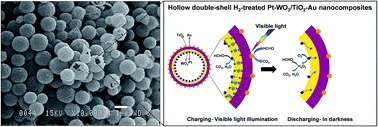Chinh-Chien Nguyen, Nhu-Nang Vu and Trong-On Do*
The development of efficient photocatalysts that can work both under visible light and in darkness remains an important research target for environmental applications. A large number of photocatalysts have been reported, but they still suffer from low activity that originates from fundamental efficiency bottlenecks: i.e., weak photon absorption and poor electron–hole pair separation when operating under irradiation, and poor electron storage capacity when operating in darkness. Herein, we report the first synthesis of hollow double-shell H:Pt–WO3/TiO2–Au nanospheres with high specific surface area, large TiO2/WO3 interfacial contact and strong visible light absorption. Because of these features, this type of nanocomposite shows high charge separation and electron storage capacity, and exhibits efficient degradation of organic pollutants both under visible light (λ ≥ 420 nm) and in darkness. In addition, CO2 generation from formaldehyde gave a high quantum efficiency of 77.6%.




